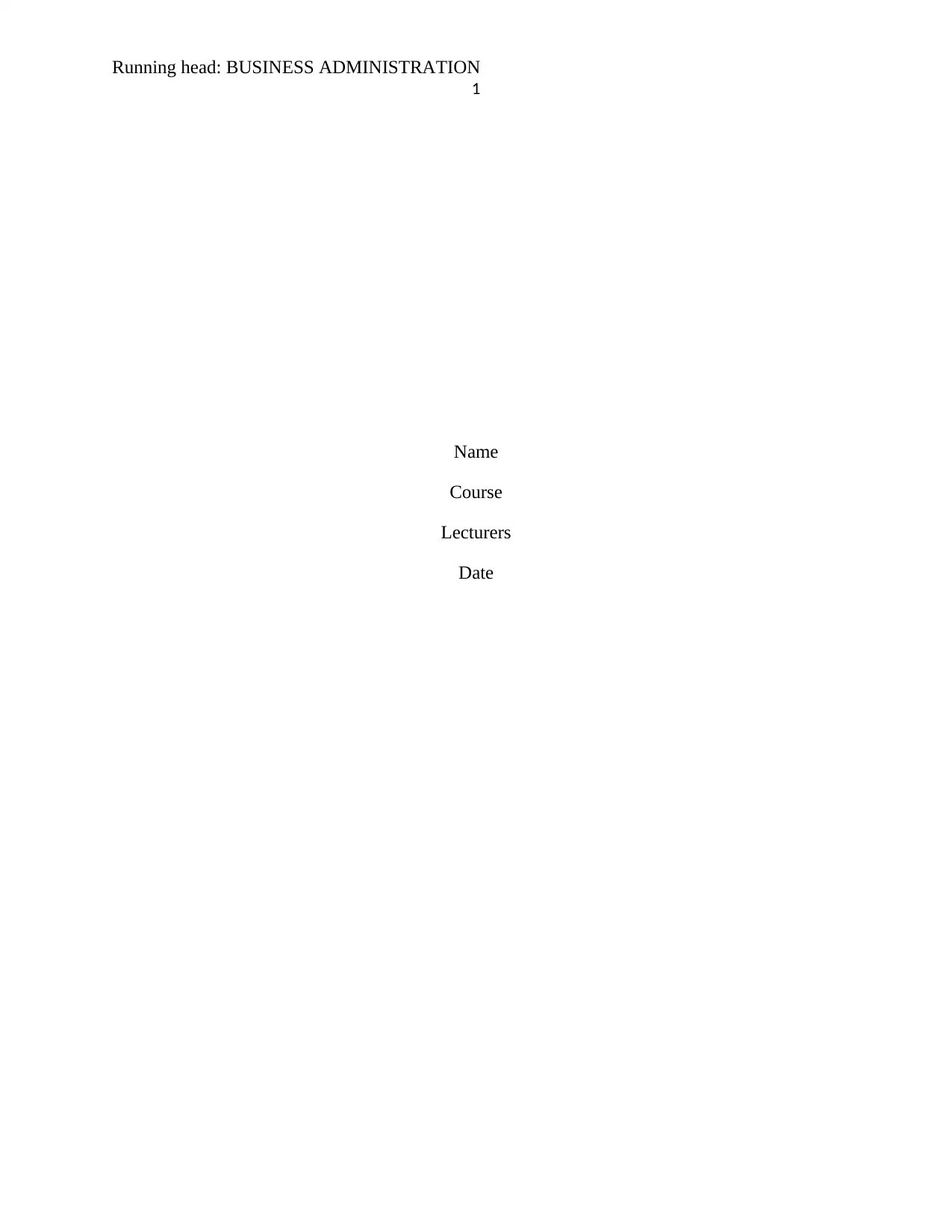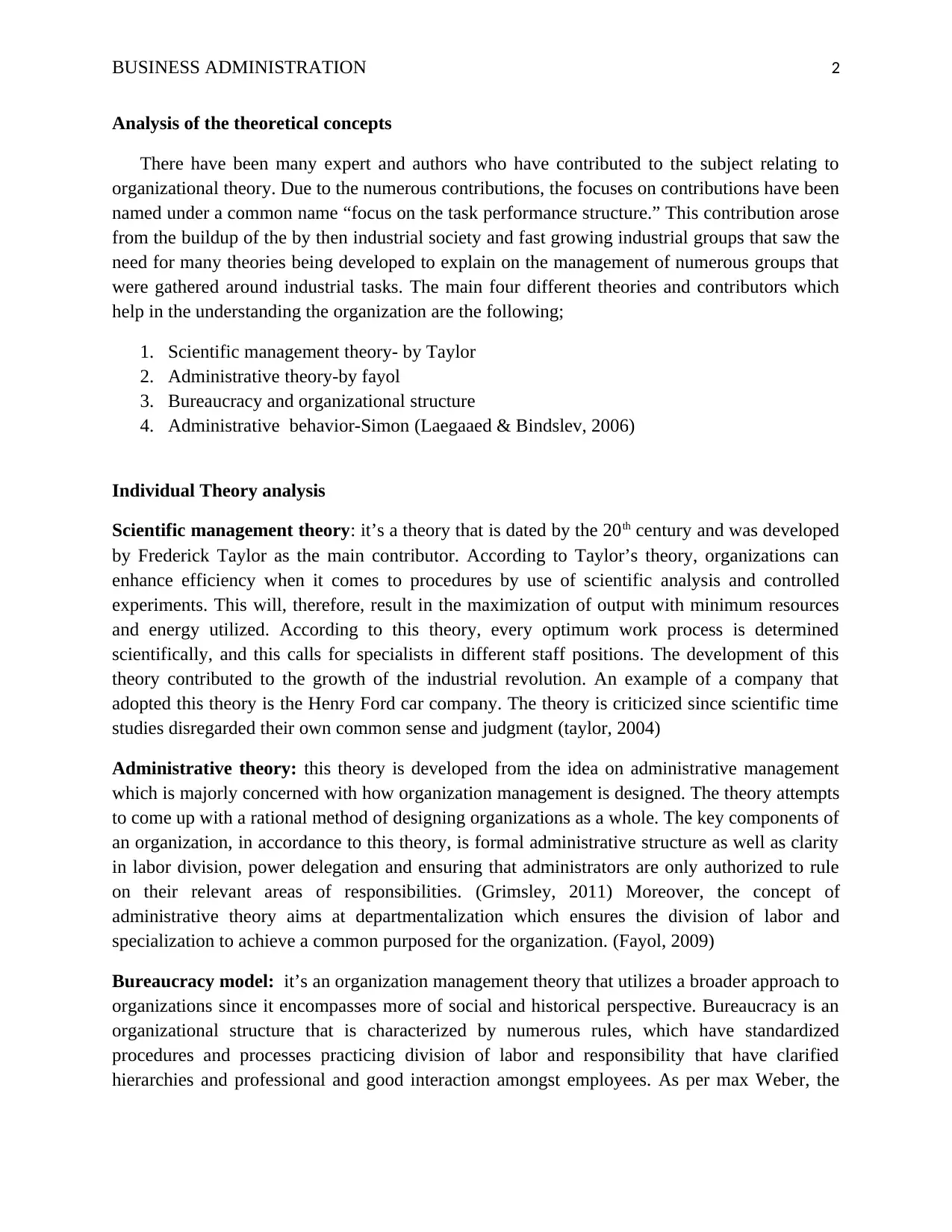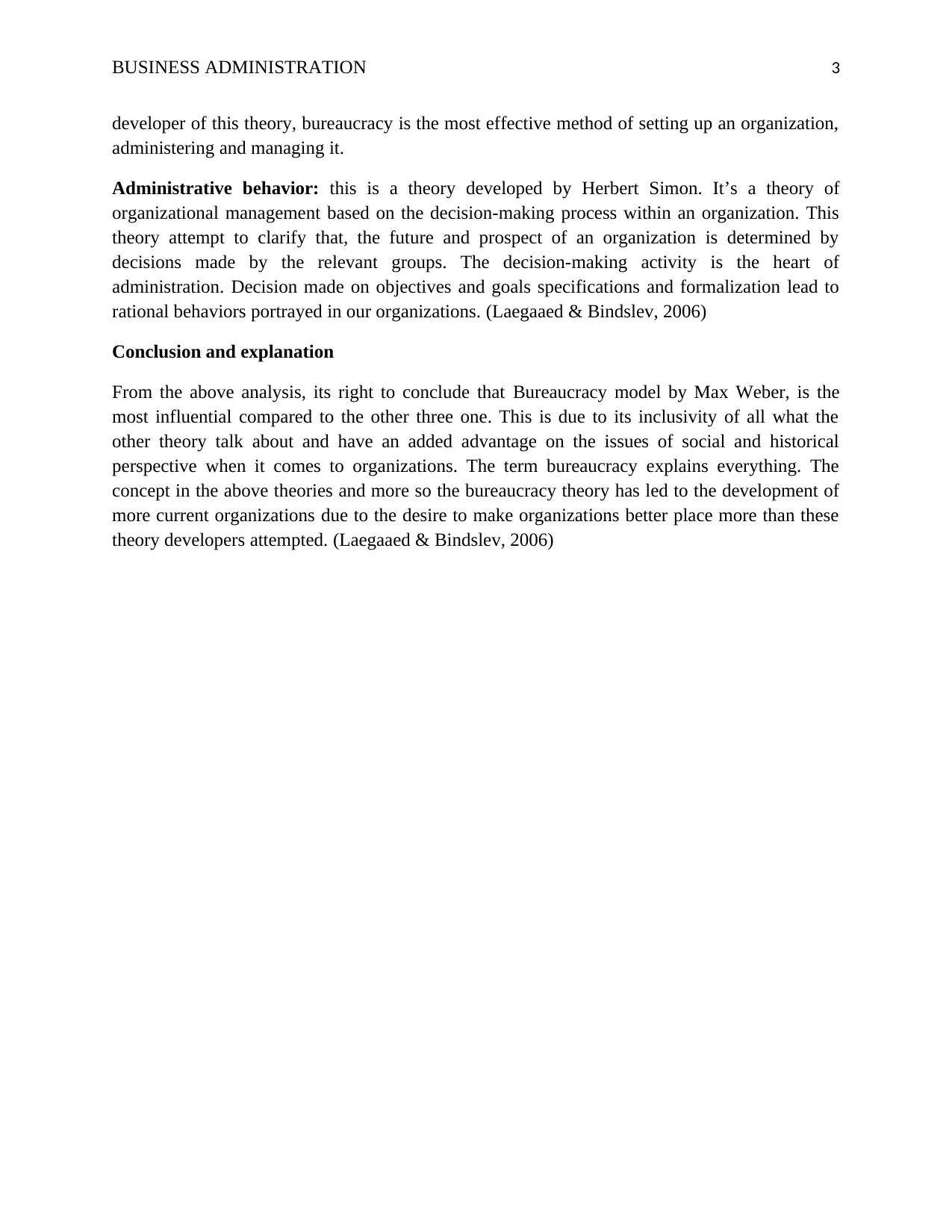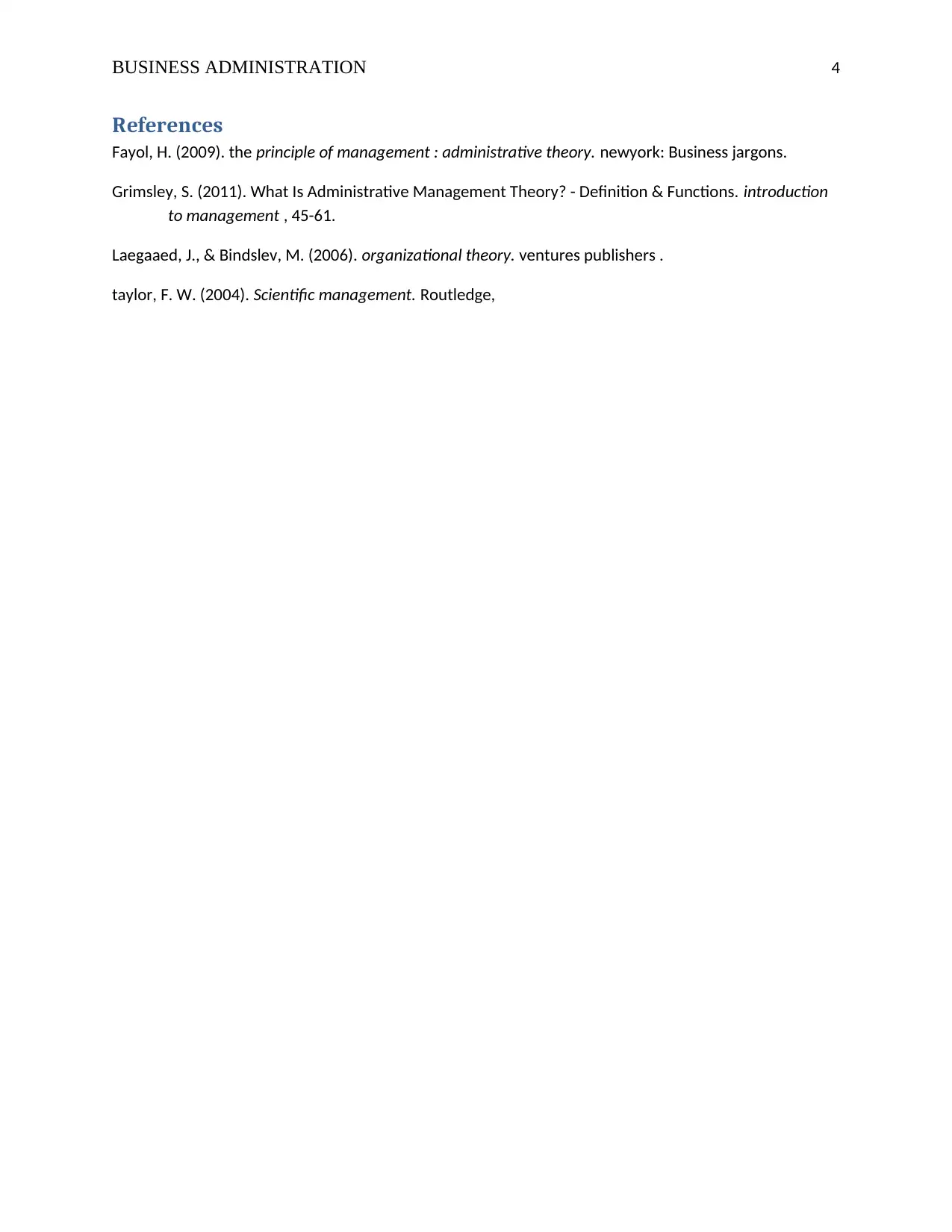Analysis of Key Theoretical Concepts in Business Administration
VerifiedAdded on 2023/05/30
|4
|790
|340
Essay
AI Summary
This assignment analyzes several key theories in business administration, focusing on their contributions to understanding and managing organizations. It examines the scientific management theory by Frederick Taylor, which emphasizes efficiency through scientific analysis; the administrative theory by Henri Fayol, which focuses on organizational structure and management; the bureaucracy model by Max Weber, which highlights standardized procedures and a clear hierarchy; and the administrative behavior theory by Herbert Simon, which centers on decision-making processes. The analysis concludes that the bureaucracy model is the most influential due to its comprehensive approach and inclusion of social and historical perspectives. The assignment also highlights the evolution of organizational theories and their impact on modern business practices.

Running head: BUSINESS ADMINISTRATION
1
Name
Course
Lecturers
Date
1
Name
Course
Lecturers
Date
Paraphrase This Document
Need a fresh take? Get an instant paraphrase of this document with our AI Paraphraser

BUSINESS ADMINISTRATION 2
Analysis of the theoretical concepts
There have been many expert and authors who have contributed to the subject relating to
organizational theory. Due to the numerous contributions, the focuses on contributions have been
named under a common name “focus on the task performance structure.” This contribution arose
from the buildup of the by then industrial society and fast growing industrial groups that saw the
need for many theories being developed to explain on the management of numerous groups that
were gathered around industrial tasks. The main four different theories and contributors which
help in the understanding the organization are the following;
1. Scientific management theory- by Taylor
2. Administrative theory-by fayol
3. Bureaucracy and organizational structure
4. Administrative behavior-Simon (Laegaaed & Bindslev, 2006)
Individual Theory analysis
Scientific management theory: it’s a theory that is dated by the 20th century and was developed
by Frederick Taylor as the main contributor. According to Taylor’s theory, organizations can
enhance efficiency when it comes to procedures by use of scientific analysis and controlled
experiments. This will, therefore, result in the maximization of output with minimum resources
and energy utilized. According to this theory, every optimum work process is determined
scientifically, and this calls for specialists in different staff positions. The development of this
theory contributed to the growth of the industrial revolution. An example of a company that
adopted this theory is the Henry Ford car company. The theory is criticized since scientific time
studies disregarded their own common sense and judgment (taylor, 2004)
Administrative theory: this theory is developed from the idea on administrative management
which is majorly concerned with how organization management is designed. The theory attempts
to come up with a rational method of designing organizations as a whole. The key components of
an organization, in accordance to this theory, is formal administrative structure as well as clarity
in labor division, power delegation and ensuring that administrators are only authorized to rule
on their relevant areas of responsibilities. (Grimsley, 2011) Moreover, the concept of
administrative theory aims at departmentalization which ensures the division of labor and
specialization to achieve a common purposed for the organization. (Fayol, 2009)
Bureaucracy model: it’s an organization management theory that utilizes a broader approach to
organizations since it encompasses more of social and historical perspective. Bureaucracy is an
organizational structure that is characterized by numerous rules, which have standardized
procedures and processes practicing division of labor and responsibility that have clarified
hierarchies and professional and good interaction amongst employees. As per max Weber, the
Analysis of the theoretical concepts
There have been many expert and authors who have contributed to the subject relating to
organizational theory. Due to the numerous contributions, the focuses on contributions have been
named under a common name “focus on the task performance structure.” This contribution arose
from the buildup of the by then industrial society and fast growing industrial groups that saw the
need for many theories being developed to explain on the management of numerous groups that
were gathered around industrial tasks. The main four different theories and contributors which
help in the understanding the organization are the following;
1. Scientific management theory- by Taylor
2. Administrative theory-by fayol
3. Bureaucracy and organizational structure
4. Administrative behavior-Simon (Laegaaed & Bindslev, 2006)
Individual Theory analysis
Scientific management theory: it’s a theory that is dated by the 20th century and was developed
by Frederick Taylor as the main contributor. According to Taylor’s theory, organizations can
enhance efficiency when it comes to procedures by use of scientific analysis and controlled
experiments. This will, therefore, result in the maximization of output with minimum resources
and energy utilized. According to this theory, every optimum work process is determined
scientifically, and this calls for specialists in different staff positions. The development of this
theory contributed to the growth of the industrial revolution. An example of a company that
adopted this theory is the Henry Ford car company. The theory is criticized since scientific time
studies disregarded their own common sense and judgment (taylor, 2004)
Administrative theory: this theory is developed from the idea on administrative management
which is majorly concerned with how organization management is designed. The theory attempts
to come up with a rational method of designing organizations as a whole. The key components of
an organization, in accordance to this theory, is formal administrative structure as well as clarity
in labor division, power delegation and ensuring that administrators are only authorized to rule
on their relevant areas of responsibilities. (Grimsley, 2011) Moreover, the concept of
administrative theory aims at departmentalization which ensures the division of labor and
specialization to achieve a common purposed for the organization. (Fayol, 2009)
Bureaucracy model: it’s an organization management theory that utilizes a broader approach to
organizations since it encompasses more of social and historical perspective. Bureaucracy is an
organizational structure that is characterized by numerous rules, which have standardized
procedures and processes practicing division of labor and responsibility that have clarified
hierarchies and professional and good interaction amongst employees. As per max Weber, the

BUSINESS ADMINISTRATION 3
developer of this theory, bureaucracy is the most effective method of setting up an organization,
administering and managing it.
Administrative behavior: this is a theory developed by Herbert Simon. It’s a theory of
organizational management based on the decision-making process within an organization. This
theory attempt to clarify that, the future and prospect of an organization is determined by
decisions made by the relevant groups. The decision-making activity is the heart of
administration. Decision made on objectives and goals specifications and formalization lead to
rational behaviors portrayed in our organizations. (Laegaaed & Bindslev, 2006)
Conclusion and explanation
From the above analysis, its right to conclude that Bureaucracy model by Max Weber, is the
most influential compared to the other three one. This is due to its inclusivity of all what the
other theory talk about and have an added advantage on the issues of social and historical
perspective when it comes to organizations. The term bureaucracy explains everything. The
concept in the above theories and more so the bureaucracy theory has led to the development of
more current organizations due to the desire to make organizations better place more than these
theory developers attempted. (Laegaaed & Bindslev, 2006)
developer of this theory, bureaucracy is the most effective method of setting up an organization,
administering and managing it.
Administrative behavior: this is a theory developed by Herbert Simon. It’s a theory of
organizational management based on the decision-making process within an organization. This
theory attempt to clarify that, the future and prospect of an organization is determined by
decisions made by the relevant groups. The decision-making activity is the heart of
administration. Decision made on objectives and goals specifications and formalization lead to
rational behaviors portrayed in our organizations. (Laegaaed & Bindslev, 2006)
Conclusion and explanation
From the above analysis, its right to conclude that Bureaucracy model by Max Weber, is the
most influential compared to the other three one. This is due to its inclusivity of all what the
other theory talk about and have an added advantage on the issues of social and historical
perspective when it comes to organizations. The term bureaucracy explains everything. The
concept in the above theories and more so the bureaucracy theory has led to the development of
more current organizations due to the desire to make organizations better place more than these
theory developers attempted. (Laegaaed & Bindslev, 2006)
⊘ This is a preview!⊘
Do you want full access?
Subscribe today to unlock all pages.

Trusted by 1+ million students worldwide

BUSINESS ADMINISTRATION 4
References
Fayol, H. (2009). the principle of management : administrative theory. newyork: Business jargons.
Grimsley, S. (2011). What Is Administrative Management Theory? - Definition & Functions. introduction
to management , 45-61.
Laegaaed, J., & Bindslev, M. (2006). organizational theory. ventures publishers .
taylor, F. W. (2004). Scientific management. Routledge,
References
Fayol, H. (2009). the principle of management : administrative theory. newyork: Business jargons.
Grimsley, S. (2011). What Is Administrative Management Theory? - Definition & Functions. introduction
to management , 45-61.
Laegaaed, J., & Bindslev, M. (2006). organizational theory. ventures publishers .
taylor, F. W. (2004). Scientific management. Routledge,
1 out of 4
Related Documents
Your All-in-One AI-Powered Toolkit for Academic Success.
+13062052269
info@desklib.com
Available 24*7 on WhatsApp / Email
![[object Object]](/_next/static/media/star-bottom.7253800d.svg)
Unlock your academic potential
Copyright © 2020–2025 A2Z Services. All Rights Reserved. Developed and managed by ZUCOL.





